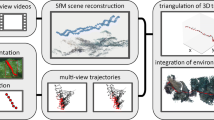Abstract
Deep-sea organism automatic tracking has rarely been studied because of a lack of training data. However, it is extremely important for underwater robots to recognize and to predict the behavior of organisms. In this paper, we first develop a method for underwater real-time recognition and tracking of multi-objects, which we call “You Only Look Once: YOLO”. This method provides us with a very fast and accurate tracker. At first, we remove the haze, which is caused by the turbidity of the water from a captured image. After that, we apply YOLO to allow recognition and tracking of marine organisms, which include shrimp, squid, crab and shark. The experiments demonstrate that our developed system shows satisfactory performance.






Similar content being viewed by others
Change history
07 July 2020
The original version of this article unfortunately contained a mistake in the Affiliation section.
References
Mandic F, Rendulic I, Miskovic N, Nad D (2016) Underwater object tracking using sonar and USBL measurements. Journal of Sensors 2016:Article ID 8070286. 10 pages
Dong W, Lu H, Yang M (2015) Kernel collaborative face recognition. Pattern Recogn 48(10):3025–3237
Wang D, Lu H, Li X (2011) Two dimensional principal components of natural images and its application. Neurocomputing 74(17):2745–2753
Lu H, Li Y, Uemura T, Kim H, Serikawa S (2018) Low illumination underwater light field images reconstruction using deep convolutional neural networks. Futur Gener Comput Syst 82:142–148
Xie S, Chen J, Luo J, Xie P, Tang W (2012) Detection and tracking of underwater object based on forward-scan sonar. Proc. of International Conference on Intelligent Robotics and Applications, pp 341–347
Li M, Ji H, Wang X, Weng L, Gong Z (2013) Underwater object detection and tracking based on multi-beam sonar image processing. Proc. of IEEE International Conference on Robotics and Biomimetics, pp 1–5
Snyder J, Silverman Y, Bai Y, Maclver M (2012) Underwater object tracking using electrical impedance tomography. Proc. of IEEE/RSJ International Conference on Intelligent Robots and Systems, pp 1–6
Walther D, Edgington D, Koch C (2004) Detection and tracking of objects in underwater video. Proc. of the 2004 Computer Society Conference on Computer Vision and Pattern Recognition, pp 1–5
Chuang M, Hwang J, Ye J, Huang S, Williams K Underwater fish tracking for moving cameras based on deformable multiple kernels. ArXiv:1603.01695.pdf
Lee D, Kim G, Kim D, Myung H, Choi H Vision-based object detection and tracking for autonomous navigation of underwate robots. Ocean Eng 48:59–68
Redmon J, Divvala S, Girshick R, Farhadi A (2016) You only look once: unified, real-time object detection. In: Proc. CVPR, pp 779–788
Redmon J, Farhadi A (2017) Yolo9000: better, faster, stronger. In: Proc. CVPR, pp 7263–7271
Li Y, Lu H, Li J, Li X, Li Y, Serikawa S (2016) Underwater image de-scattering and classification by deep neural network. Comput Electr Eng 54:68–77
Lu H, Li Y, Uemura T, Ge Z, Xu X, He L, Serikawa S, Kim H (2018) FDCNet: filtering deep convolutional network for marine organism classification. Multimedia Tools and Applications 77(17):21847–21860
Lu H, Li Y, Mu S, Wang D, Kim H, Serikawa S (2018) Motor anomaly detection for unmanned aerial vehicles using reinforcement learning. IEEE Internet of Things 5(4):2315–2322
Lu H, Li Y, Chen M, Kim H, Serikawa S (2018) Brain intelligence: go beyond artificial intelligence. Mobile Networks and Application 23(2):368–375
Lu H, Li Y, Nakashima S, Serikawa S (2016) Turbidity underwater image restoration using spectral properties and light compensation. IEICE Trans Inf Syst E-99D(1):219–226
Lu H, Li Y, Zhang L, Serikawa S (2015) Contrast enhancement for images in turbid water. J Opt Soc Am A 32(5):886–893
Serikawa S, Lu H (2014) Underwater image dehazing using joint trilateral filter. Comput Electr Eng 40(1):41–50
Kalal Z, Mikolajczyk K, Matas J (2010) Tracking-Learnig-detection. IEEE Trans Pattern Anal Mach Intell 6(1):1–17
Kalal Z, Mikolajczyk K, Matas J (2010) Forward-backward error: automatic detection of tracking failures. In: ICPR
Lucas BD, Kanade T (1981) An iterative image registration technique with an application to stereo vision. International Joint Conference on Artificial Intelligence 81:674–679
Acknowledgements
This work was supported by Leading Initiative for Excellent Young Researcher (LEADER) of MEXT-Japan (16809746), Grants-in-Aid for Scientific Research of JSPS (17K14694), Research Fund of State Key Laboratory of Marine Geology at Tongji University (MGK1608),, Research Fund of The Telecommunications Advancement Foundation, Open Collaborative Research Program at National Institute of Informatics Japan (NII), Japan-China Scientific Cooperation Program (6171101454), and International Exchange Program of National Institute of Information and Communications (NICT), and Fundamental Research Developing Association for Shipbuilding and Offshore.
Author information
Authors and Affiliations
Corresponding author
Rights and permissions
About this article
Cite this article
Lu, H., Uemura, T., Wang, D. et al. Deep-Sea Organisms Tracking Using Dehazing and Deep Learning. Mobile Netw Appl 25, 1008–1015 (2020). https://doi.org/10.1007/s11036-018-1117-9
Published:
Issue Date:
DOI: https://doi.org/10.1007/s11036-018-1117-9




